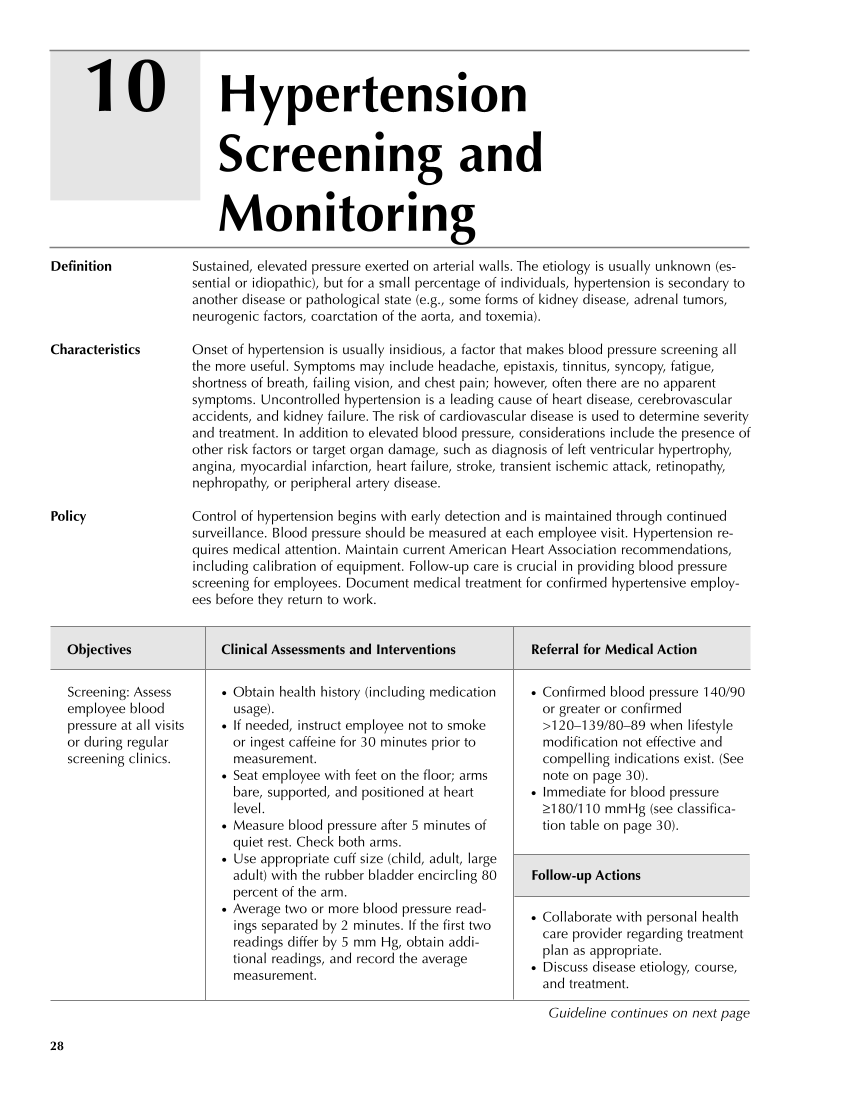10 28 Definition Sustained, elevated pressure exerted on arterial walls. The etiology is usually unknown (es- sential or idiopathic), but for a small percentage of individuals, hypertension is secondary to another disease or pathological state (e.g., some forms of kidney disease, adrenal tumors, neurogenic factors, coarctation of the aorta, and toxemia). Characteristics Onset of hypertension is usually insidious, a factor that makes blood pressure screening all the more useful. Symptoms may include headache, epistaxis, tinnitus, syncopy, fatigue, shortness of breath, failing vision, and chest pain however, often there are no apparent symptoms. Uncontrolled hypertension is a leading cause of heart disease, cerebrovascular accidents, and kidney failure. The risk of cardiovascular disease is used to determine severity and treatment. In addition to elevated blood pressure, considerations include the presence of other risk factors or target organ damage, such as diagnosis of left ventricular hypertrophy, angina, myocardial infarction, heart failure, stroke, transient ischemic attack, retinopathy, nephropathy, or peripheral artery disease. Policy Control of hypertension begins with early detection and is maintained through continued surveillance. Blood pressure should be measured at each employee visit. Hypertension re- quires medical attention. Maintain current American Heart Association recommendations, including calibration of equipment. Follow-up care is crucial in providing blood pressure screening for employees. Document medical treatment for confirmed hypertensive employ- ees before they return to work. Objectives Clinical Assessments and Interventions Referral for Medical Action Hypertension Screening and Monitoring ● Confirmed blood pressure 140/90 or greater or confirmed 120–139/80–89 when lifestyle modification not effective and compelling indications exist. (See note on page 30). ● Immediate for blood pressure ≥180/110 mmHg (see classifica- tion table on page 30). Follow-up Actions ● Collaborate with personal health care provider regarding treatment plan as appropriate. ● Discuss disease etiology, course, and treatment. Screening: Assess employee blood pressure at all visits or during regular screening clinics. ● Obtain health history (including medication usage). ● If needed, instruct employee not to smoke or ingest caffeine for 30 minutes prior to measurement. ● Seat employee with feet on the floor arms bare, supported, and positioned at heart level. ● Measure blood pressure after 5 minutes of quiet rest. Check both arms. ● Use appropriate cuff size (child, adult, large adult) with the rubber bladder encircling 80 percent of the arm. ● Average two or more blood pressure read- ings separated by 2 minutes. If the first two readings differ by 5 mm Hg, obtain addi- tional readings, and record the average measurement. Guideline continues on next page
Purchased from OEM Press by (ge corporate access). (C) 2013 OEM Health Information, Inc. All rights reserved.












































































































































































































































































































































































































































